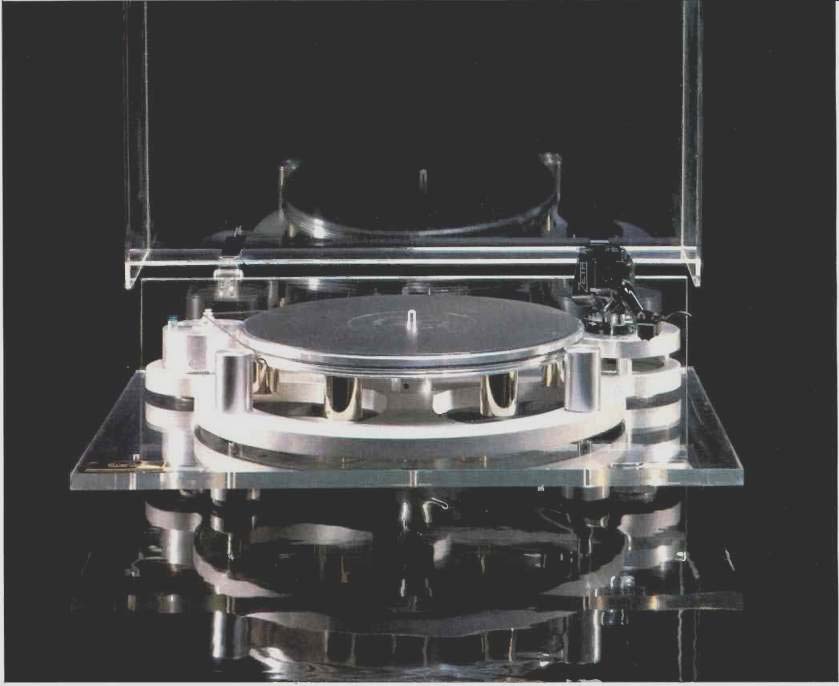
Manufacturer's Specifications:
Drive System: Belt.
Speeds: 33 1/3 and 45 rpm.
Wow & Flutter: 0.04%.
Rumble: -78 dB.
Speed Accuracy: ± 0.1 %.
Dimensions: 21 1/4 in. W x 7 1/2 in. H x 16 3/4 in. D (54 cm x 19 cm x 42.6 cm), including dustcover.
Weight: 37 lbs. (16.8 kg).
Price: $1,190.
Company Address: c/o Reference Monitor International, 2615 Jacaranda, Carlsbad, Cal. 92008.
Michell Engineering was one of the first companies I know of to make what might rightfully be termed an audiophile turntable. Back in the early 1970s, John Michell designed what he called the Hydraulic Reference turntable. With its striking appearance, that unit turned more than phonograph records-it turned a lot of heads too. The present GyroDec turntable bears a strong resemblance to the Hydraulic Reference, even though many of the early features, including the hydraulic system, have long since been discarded in favor of more conservative engineering. The original hydraulic turntable featured a rotating bath of high-viscosity oil and an adjustable paddle. Although a synchronous motor was used, the turntable was designed to run slightly fast. By adjusting the drag of the paddle in the rotating oil bath, the speed of the platter could be slowed down. The exact speed was determined by using the stroboscopic disc which was supplied with the turntable.
Another feature of the original turntable was the use of cylindrical pods arrayed around the periphery of the platter.
The pods faced up, and the phonograph record was sup ported only at its edges. In those days a great deal of effort was made to reduce the buildup of static electricity in a record, because noises caused by electrical discharges between the record and the phono cartridge could be heard during playback. The pods were used not only to reduce this static-electricity effect but also-since they were made of solid brass-to place extra mass at the periphery of the turntable platter to increase its inertia. This increased the flywheel effect of the platter, thus reducing wow and flutter.
The GyroDec (which is made in England) still uses these pods, but only for their inertial effect; the disc rests on a conventional platter and mat, and the pods are attached to the underside of the platter.
First Impressions
The GyroDec makes a very strong visual impression. It will never be mistaken for any of the usual run of mass-market turntables: Its styling is very, very "modern," making use of handcrafted, crystal-clear acrylic plastics and highly polished, plated metal parts. In fact, the cylindrical metal pods are gold-plated. Other metal surfaces, such as the subchassis, have a satin-smooth aluminum finish. But while the quality of the styling is open and airy, the whole assembly, including the clear acrylic cover, is very heavy; the mass necessary to achieve a stable record-playing system is engineered into the GyroDec while remaining beautifully disguised. There is no turntable base in the usual sense; instead of the closed, rectangular box we are all used to seeing, the GyroDec has a main support base made from a single sheet of thick, clear acrylic.
Features
While it appears upon first look that styling is paramount in the GyroDec, a closer examination reveals that good engineering principles are not compromised to achieve the excellent appearance.
The GyroDec has a low-voltage synchronous motor with a stepped pulley on the spindle for 33 1/3 and 45 rpm. The motor is located at the left rear corner of the turntable and is mounted directly to the main support base. The flexible belt which drives the outside rim of the turntable is completely accessible, so changing the turntable speed, by moving the belt from one step on the motor pulley to another, is very easily accomplished. The power supply is a separate unit with a 3-foot cord that plugs into an a.c. outlet and a 6-foot cord that plugs into the motor. No a.c. line voltage is present at the turntable, so hum from this source is not a problem.
There are three grooves around the edge of the platter. The unit that I tested had a single drive belt; however, I have been informed that later versions have two belts to improve speed stability. A ring, which is part of the suspended subchassis, surrounds the motor housing. This ring was intended originally to allow the use of two tonearms simultaneously, with the motor mounted elsewhere on the main support base. (Most audiophiles eschew the practice of using two tonearms to play the same record because of the interaction between the two arms that can result. This inter action arises when mechanical energy travels through the vinyl record material from one pickup stylus to the other.) The clearance between this ring and the motor housing was less in the unit I tested than in later models, but, by carefully balancing the turntable, I experienced no problems caused by the narrow clearance.
The suspended subchassis is of aluminum, cast in the form of a large central ring and two smaller ones. The large ring has spokes to a central hub which carries the main turntable bearing. The smaller rings, at the left and right rear, hold the motor housing and the tonearm mounting platform, respectively. The spokes of the large subchassis ring are weighted with lead to increase the suspended mass and to damp any resonance.
The springs on which the subchassis is suspended form an equilateral triangle, one corner of which is located in line with the center of the platter and the tonearm's mass. The other two springs are equidistant from this line.
The six gold-plated brass weights on the underside of the platter are distributed evenly around its periphery. This accomplishes at least three things: First, as mentioned earlier, it causes the effective mass of the platter to be in creased, thereby increasing the flywheel effect without proportionately increasing the mass load on the main bearings.
It also puts the effective mass closer to the horizontal plane of the main bearing, which lessens the tendency of the platter to wobble. Last, it helps to damp the natural ringing modes of the platter. These cylindrical weights, which are 1.25 inches in diameter and 1.5 inches long, increase the platter weight to 9.5 pounds.
The main bearing is made of phosphor bronze and has a tolerance of 0.0001 inch. A hardened-steel ball is fitted to the main shaft, which extends down from the center of the platter.
The main platform is first leveled by adjusting the three rubber-tipped feet, and then the subchassis can be leveled by adjusting the three compression-type springs, which are under easily removable covers. These springs have foam pads inside and rubber pads on each end to damp any ringing.
Tonearms can be mounted to a circular acrylic disc which is supplied with the turntable. This disc fits into the circular ring on the right rear of the subassembly and is locked in place with three screws. A number of tonearms can be mounted, adjusted, and then easily interchanged by using a different disc for each arm. For measurements and listening tests, I used the Zeta tonearm and the Goldbug Clement II cartridge, which are also imported by Reference Monitor International. (This tonearm and cartridge combination is the subject of a separate report in this issue.)
Measurements and Listening Tests
-------MEASURED DATA------
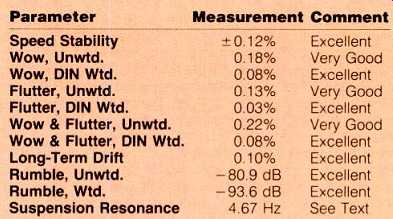
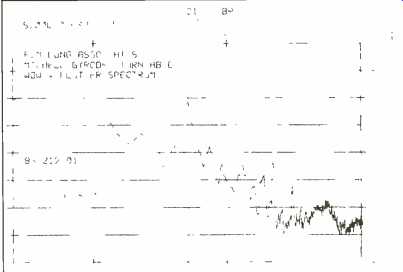
Fig.
1--Computer plot of wow and flutter spectrum, from 0 to 100 Hz. The peak at
5.9 Hz is due to the tonearm/cartridge resonance; actual turntable wow is very
low
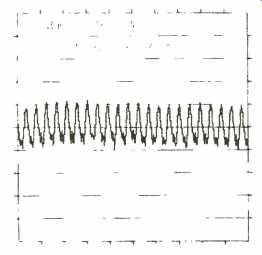
Fig. 2--Speed drift over 42-S period. The variations at 0.56 Hz are related
to the 33 1/3-rpm speed. Note the high stability, with very low short-term
and long-term drift.

Fig. 3--Speed stability referenced to 3,150-Hz test tone on B & K 2010
test record. The turntable is running about 0.94% fast, as shown by displaced
curve, but is very stable at that speed.
As has been the case in my past reports for Audio, I will try to show correlation between the technical measurements I made on the Michell turntable and the comments of members of a listening panel. The panel members are asked not to make any verbal comments while they are listening to particular selections; they are asked to write down such comments and, after the selection has ended, to discuss these and any other reactions they might have with other panel members. A test form has been developed which allows rating the sonic quality of the reference system and the equipment being tested on a scale from 0 to -5. High-quality recordings which feature piano, percussion, vocals, orchestral crescendos, etc. are selected to allow the panel members to make their evaluations. The ratings of 0 to -5 were chosen because it is easier to hear faults in reproduced sound than to hear things which can be considered positive. I look at the results of the ratings, the written comments, and notes which I have made during the discussions, and try to relate these to my technical measurements.
I always adjust the equipment being evaluated and make the technical measurements before the listening sessions to make certain that the equipment is performing properly.
Figure 1 shows the spectral distribution of energy caused by wow and flutter. The main peak, at 5.9 Hz, is due to the resonance of the tonearm mass and the cartridge compliance. This peak shows that the percentage of wow, read from a wow and flutter meter, would be even lower if the contribution of the tonearm/cartridge could be removed.
The actual wow, caused by the turntable alone, is thus very low. The ratings given by the listening panel to the reference system and the GyroDec were essentially identical for the reproduction of piano recordings, except for staccato pas sages. The quality of sustained piano tones, which are very difficult to reproduce without waver, was deemed excellent.
Figure 2 shows that, over a 42-S period, the GyroDec turntable is very stable. The speed drifts less than ±0.10% from the 331/3-rpm speed during this period of time, and the short-term cyclical variation is less than ±0.20%. The short term variations occur once per revolution of the turntable or at a rate of 0.56 Hz. Both the long- and short-term drift are very low and must be considered excellent. Figure 3, a graph of the change in frequency of the 3,150-Hz wow-and-flutter test tone on the B & K 2010 test record, shows that the GyroDec is running about 0.94% fast and that it holds this speed very closely over a long period. Because the Nicolet 660A-2D FFT spectrum analyzer which I used for this measurement was in the "zoom" mode, with a total window width of only 80 Hz, the 16 samples were necessarily taken over a long period of time.
The spectrum of the GyroDec's rumble components is shown in Fig. 4. Once again, the contribution of the tonearm/ cartridge resonance can be seen. The actual rumble caused by the turntable would measure much lower if the output due to this resonance could be removed from the total. Even with this effect, which of course contributes to the perceived sound quality, the graph shows that the GyroDec has very low rumble-the lowest I have ever measured for a turntable. No comments were made by the listening panel about rumble, and I consider the performance of the GyroDec to be superb in this regard.

Fig. 4--Rumble spectrum, measured with B & K 2010 test record. Main output
is from tonearm/ cartridge resonance at 5.9 Hz. Rumble is the lowest I have
measured for a turntable.
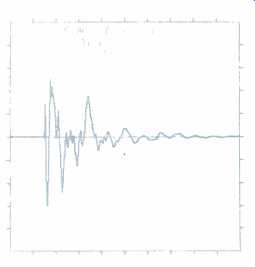
Fig. 5--Output vs. time for mechanical shock applied to edge of a record,
with stylus resting in groove.
Figure 5 shows the output caused by a mechanical impulse applied to the edge of a stationary record with the phono stylus resting in a groove. This test is made to determine the turntable's effectiveness in damping the mechanical energy in the record. The GyroDec is only moderately effective in this regard; certain comments made by panel members, who rated the reference system as being clearer and more precise when reproducing a staccato piano passage, may be related to this delayed energy.
Figure 6 is a graph of the spectral distribution of the energy caused by a series of mechanical impulses similar to the impulse applied for Fig. 5. As is the case for all the turntables I have tested, there is a great deal of energy near the tonearm/cartridge resonance--in this case at 5.9 Hz. (The exact frequency varies with different tonearm/cartridge combinations, of course.) The cursor is set to 100 Hz, where the next greatest output occurs. The fact that this output is due to delayed energy added to the desired signal is probably more important than the exact distribution of that energy. This energy probably contributed to the coloration of human voice which was noted by one panel member. The coloration was slight, but it was noticed because it was less apparent in the sound of the reference system.
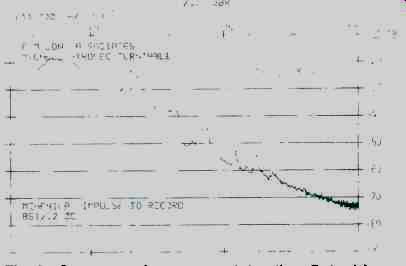
Fig. 6--Spectrum of output caused by a series of mechanical Impulses to edge
of a stationary record, with stylus resting in groove near the middle of the
disc. Output is highest at arm cartridge resonance; cursor is at 100 Hz, where
the next greatest output occurs.

Fig. 7--Output vs. time response for mechanical shock applied to heavy platform
on which the turntable rested. The GyroDec's isolation from the shock is excellent.
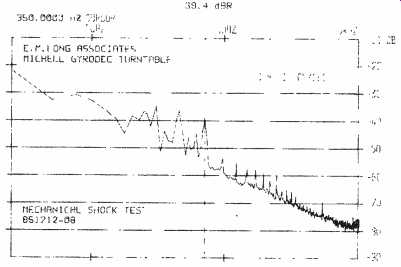
Fig. 8--Spectrum (to 5 kHz) of the vibrations caused by mechanical shock applied
to platform supporting the turntable.
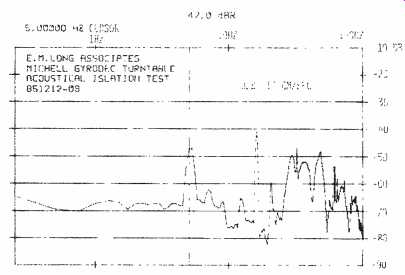
Fig. 9--Spectrum (to 100 Hz) of the vibrations from a 100 dB SPL acoustic
field at the surface of a record. Cartridge stylus is resting in a groove near
the middle of the record.
Figure 7 shows the output which resulted from a mechanical shock applied to the heavy platform on which the turntable rested during all of the technical testing. This platform is extremely massive and very well isolated from mechanical vibrations which might otherwise reach the turntable. The force of this impulse was set to the highest level I nave used on any previous turntable. The isolation of the GyroDec is excellent. The tendency for the vibration to die down and then come up again is due in part to the fact that the suspension has some closely spaced resonances which add and cancel at a very low frequency. There is also a tendency for the turntable subchassis to rotate slightly at this low frequency.
Figure 8 shows the spectral distribution of the energy caused by a series of mechanical impulses applied, as in Fig. 7, to the turntable platform. The cursor is set at 350 Hz, which is the highest frequency of a number of spikes which appear between about 100 and 350 Hz. These energy clusters could be a source of coloration, but they are hard to correlate directly with any comments made by the listening panel. The other closely spaced group of spikes, which appear between about 500 Hz and 2 kHz, are at a very low level and probably do not contribute any significant coloration to the sound.
Figure 9 shows the spectrum of the output generated by a very slow sweep of frequencies from 20 to 100 Hz, which produces an acoustical level of 100 dB SPL at the surface of a record on the turntable. The stylus was resting in the groove of the record, which was stationary. This is a very severe test. The GyroDec did quite well-breakthrough out put is at least 30 dB below the 10 cm/S reference-and should be considered very good as far as acoustical isolation is concerned. However, I have seen better performance from other turntables that I have tested. The output at 5.9 Hz is again due to the tonearm/cartridge resonance, while the output at higher frequencies is probably due to internal eigenmodes (natural modes of resonance) of the suspension springs. The results are still good enough to allow the GyroDec to be classified as an audiophile turntable.
Conclusions
As I have said, the GyroDec has the lowest rumble of any turntable that I have measured. It compared well with the reference standard, except for slightly greater coloration on voice and a bit more blurring on staccato piano passages.
On most program material, the difference was extremely subtle and the listening-panel ratings were identical for the GyroDec and the reference system. I should mention that the reference system did not employ vacuum clamping of the record. I have found vacuum clamping to be so effective that to use it on a reference system when evaluating the sonic attributes of a turntable without it, like the GyroDec, would be almost like comparing apples to oranges. I did use a very good turntable platter-to-record interface on the reference system. I recommend that you audition the Michell GyroDec with the best associated equipment; I am certain that you will be impressed.
-Edward M. Long
(Source: Audio magazine, Dec. 1986)
Also see: Oracle Turntable (Mar. 1982)
Linn Axis Turntable (May 1987)
Zeta Standard Tonearm and Goldbug Clement II Cartridge (Dec. 1986)
= = = =